|
Designed
for 1024x768 by
archeophotography.com
Homepage
|
|
 PaleoSeti (or Ancient
Aliens) theory frequently asked questions
The Paleo-Seti or Ancient Aliens theory is highly controversial. Not
just for the last few years, but ever since the late 1960's when the theory
really gained popularity. During the 1970s and 1980s there was a lot of very valueable
discussion between Paleo-Seti theorists and people that oppose the theory.
During my youth I witnessed many of those discussions on TV, in books, during
slide show presentations or even in classrooms with open minded teachers.
If you read on, you will never the
phrase “Paleo-Seti Theory believer”. In science there is no
“believing”. Either you gain knowledge by research or you don't. The
Ancient Astronaut theory has so many roots in hard science, it is backed up by
so much evidence that “believing” is not necessary. Believe is very
useful, but should be left to religions.
Unfortunately ever since the mid 1990s those valuable discussions stopped more
and more. In the last 10 years I have not heard a respectful discussion about
the theory anywhere but in private conversations and – sometimes –
on internet forums. Both sides – critics and non critics - are to blame for
this equally.
On the one hand you have
Ancient
Astronaut theorists that are only interested in one thing: Making
money. They
write books about everything they can get a hold of, write about
Ghosts, Big Foot and the Loch Ness monster if it only sells. Research
is conducted in
the most shallow way possible, scientific research completely ignored
and every
criticism is immediately dismissed as a conspiracy. I'm not naming any
authors
in particular, but if you read some books you will pretty much
immediately know
who I'm talking about. It's up to the readers to weed out these 'bad
apples'.
On the other hand you have members
of the scientific community that are under constant fear of not being published in thei field
anymore, if they have an open mind to the Ancient Aliens theory in public.
Publicly they HAVE TO find the theory ridiculous, outrageous and completely not
acceptable. In private conversations this sometimes looks a bit different. In
my experience many scientists are more open to the theory as you might
think.
In this FAQ page I would like
to show you some of the questions I was asked many times in the last
25 years. Many of those answers are from my own research and many interesting
discussions I had during this time.
Index:
1. Can we travel to the stars?
2. There are too many stars. Nobody can come to us by coincidence!
3. Isn't the Ancient Astronaut Theory nothing like a bunch of "looks like" mysteries?
4. Isn't the Ancient Astronaut Theory and many of it's "pillars" already debunked?
5. We have not found a shred of evidence of aliens in archaeological digs!
6. There are no scientific works in the Ancient Astronaut/PaleoSeti field. How can you take the Theory seriously?
7. The Ancient people were not stupid! They were able to build all the buildings themselves. No aliens needed!
8. PaleoSeti Theorists see only what they want to see and take everything out of context
9. Ancient Astronaut Theorists publish the same stuff over and over. Nothing new is coming out!
10. What do you think about the Ancient Aliens TV Show?
11. What do you think about UFOs?
12. Astronomical alignments - Nothing but calendars?
13. Quotes and footnotes on this webpage
14. What do you think is the best proof for the Ancient Astronaut Theory?
15. Where is the hard evidence?
16. Where can I get more information?
17. Why are the pictures on this website so small?
18.
The Ancient Astronaut Theory compares apples to oranges! Some of the
artifacts you study and compare are divided not only by distance but
also by several thousand years time difference. How does that work?
19. Archaeology doesn't need the PaleoSeti Theory to explain things
1. Question: Can we travel to the stars?
A lot of Astronomers make the following statement: The ancient astronaut
theory is invalid and does not have to be discussed any further for one simple
reason: The distances in the Universe are too vast for space travel. Albert
Einstein showed us in his Theory of Relativity (E=mc2) that faster-then-light travel is
not possible. Even
speeds close to the speed of light require so much energy that they never could
be achieved.
Even close star systems are 4-20 light years away from earth and it is very
unlikely that intelligent life exists there. Even if an intelligence could
reach 50% of the speed of light a spaceship would take at least 50 years to come here.
Of course they would need another 50 years to get back home. That would make
“expeditions” of other intelligences extremely unlikely, especially if their planet would be 1000 light years or more away.
Answer/Argument:
This is a very interesting point indeed. Because if
the above is correct, we really don't have to discuss anything any further. But
let's look at this a bit more closely: So we know the universe is vast and the
stars and surrounding planets are far away. That's a fact and nobody disputes
this. But here is another fact. ANY distance can be travelled by ANY object
that has ANY speed that is not zero. Makes sense? So what does that mean? It
means that somebody can walk around the world just like somebody who uses an
airplane. It just takes longer. Yes, a lot longer. But nevertheless it's
possible. And people have done it. Every trip, no matter how long, is just a
matter of TIME. In 1972 the spacecrafts Voyager 1 and 2 were launched and both
left our solar system just recently. The speed of both is not even snail's pace
in relation to cosmic distances. But even as slow as they are, they WILL get
there eventually. The scientists that built the two spacecraft are so certain
about this, they included a message to extraterrestrial intelligences that
might capture them sometime. So that is proof that astronomers do believe in
extraterrestrial life :) But that's a different story...
So, we established that all we need to reach the stars is time. But do
we have time? Not in our hectic, self-centered world. In our western society
everything evolves around our own egos. Maybe one generation up or down. But
that's about it. Very few explorers in human history ever went on a trip that
they knew they would not come back from. But there were a few. Even fewer
explorers ever set out and knew that they would never reach to where they were
going.
But we do know that in ancient societies kingdoms have been built to last
centuries. Strict rules were put in place in order to ensure that certain
families rule over many generations. In fact, this type of society was much
more successful then our modern and young democracies. A few peoples even built
into their society models that many things will take several generations to
complete. One example is the cathedral of Cologne in Germany. The project was
so huge and time consuming that the original builders knew it was impossible to
complete in one lifetime and needed many generations for completion. Imagine an
advanced society that thinks like this but in terms of space exploration. What
if an expedition to the stars would be planned not with the restriction of the
lifetimes of a few individuals but many GENERATIONS. All over sudden we could
think in much larger terms or distances.
A star that's e.g. 200 light years away could be reached in 400 years if we
somehow managed to reach 50% of the speed of light. 400 years, that would be 5
generations. If we somehow could build such a spaceship that's able to house
the needs of many generations of space travelers, distances would not be
measured in light years anymore, but the number of generations.
Those Generation Spaceships are not a new idea. Science Fiction writers
and early rocket scientists proposed the idea of an “interstellar
ark” as early as the 1920s. In the 1970s and 80s NASA proposed several
ideas and concepts how those spaceships could look like. Here are some
examples:
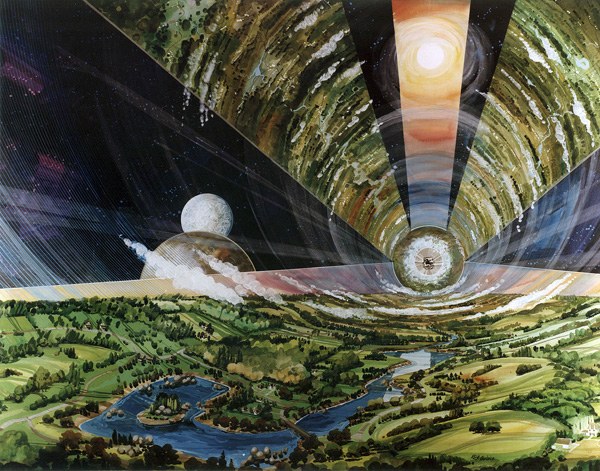
Image source: Wikipedia commons
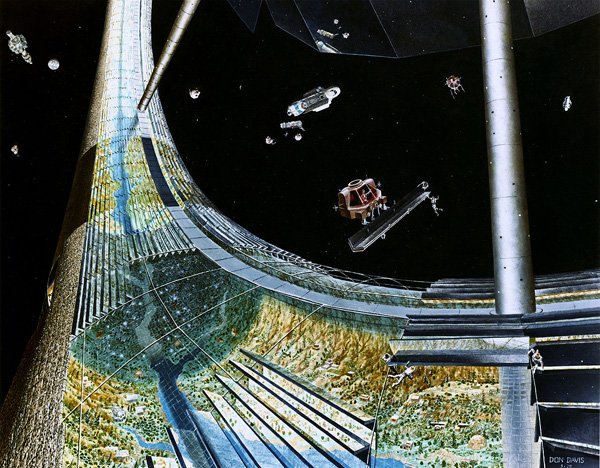
Image source: Wikipedia commons
The idea
seems to "flare up" every five years or so and is usually introduced
as "brand new". Recent examples are the National Geographic issue
No1/2013. A great recent visualization of the Generation spaceship concept is
rendered in the Hollywood movie "Elysium" with Matt Damon. The
movie's plot is rather poor, but if you are interested how such a Generation
Spaceship could look like, it's worth watching.
The amazing thing about Generation Spaceships is that they are very doable with
technology that is already known to us today or it would need relatively little
to overcome existing problems. Yes they would be huge and it would take many
resources of all people of the whole planet, but doable they would be.
In fact we already made our first attempt to create such a Genereation Spaceship. It was called Biosphere 2
and was constructed in the late 80s/early 90s as an experiment for
scientists to live in a completely self contained biological
atmosphere, separated from the rest of the world. The experiment was
conducted over 2 years and then a second mission for about 10 month,
before everything fell apart due to political reasons.
Experts are arguing about if the experiment was a success or not, but I
believe it was a good start and it shows that with a little tweaking
the technology could be ready for such an undertaking. Unfortunately
Society and human factors like funding, greed etc. are still the major
factor of why we as a society are not ready for such a step, yet. 200
years from now, maybe...

Image source: Wikipedia commons, Author: John de Dios
Aside from Generation Spaceships – which I believe are the best way to
travel to the stars – there is the ever popular, ever disputed faster then
light travel. With what we currently know this is not possible. Although in the
recent decades Quantum Physics made quite a bit of progress and scientists
sometimes observe effects that can't be explained by “regular”
physics. So we might not have seen the end of this discussion after
all.
|
2. There are too many stars! Nobody can come here by coincidence!
So let's say we can get to the stars with generation spaceships as
explained above. There are trillions of stars out there. Even if there is
intelligent life out there on a tiny percent of planets (that we don't know
exist), the coincidence that they would find our small, insignificant planet is
so remote, that we don't have to waste any time or money to do any Ancient
Astronaut research, especially since life on earth is such a rare coincidence
by itself.
Answer:
It's pretty naive to think that space travellers would take of in a random
direction and chance to hit intelligent live at some point in time by
coincidence. In recent years telescopes and other detection instruments have
hugely improved. The Kepler space telescope alone detected thousands of planets
outside of our solar system. A few years ago we even found planets that are
located in the “habitable” zone around other stars and are good
candidates for extraterrestrial life. Wouldn't it be a good guess, that we
would pick such a planet to go to instead of randomly “point and
shoot”?
|
3. Isn't the Ancient Astronaut Theory nothing but a bunch of "looks like" mysteries?
Ancient Astronaut Theorists always point out ancient carvings, drawings
etc. And say “That looks like and astronaut, a spaceship or anything other
technical. But the archeologists say it's a flower, jaguar, snake or other
natural “down to earth” things. Doesn't Occams Razor suggest that the
simplest explanation tends to be the right one? I mean you can see sheep in
clouds, faces in smoke. Why not see aliens and spaceships in ancient
carvings?
Answer:
I can best answer this question with some examples. Look at the
following:
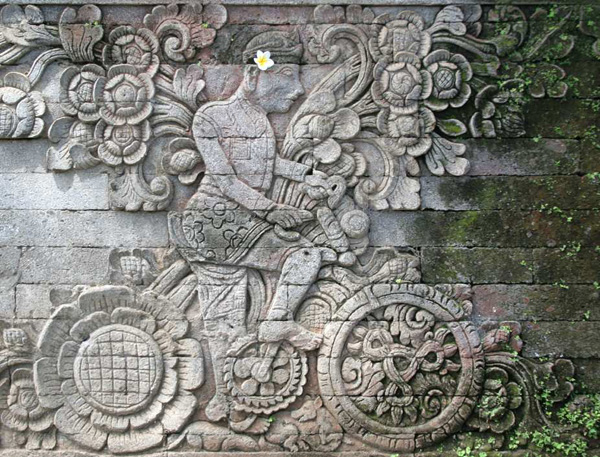
Image source: Cyclist carving.
http://richard-seaman.com
This is the photo
of a carving on a temple wall in Indonesia. What do we see? In the middle a
figurine that's standing or walking. The person holds something in their hands.
The person is surrounded by flowers, possibly a lotus plant. Now somebody could
go out of their way to explain the above carving with the symbolism of the
depicted flowers etc. The fact that it looks like a bicycle could easily
dismissed as a simple “looks like” mystery. Occams Razor?Not this
time. This carving is actually not ancient. It was made during the time of
colonization of Indonesia. The artist never saw a bicycle before and had no
idea what it was. He was fascinated when he saw this magic thing that allowed
the rider to go in incredible speed. He had no idea what it was or how it
worked. So he had to carve what he knew. So the wheels became flowers as the
whole thing was beautiful and flowers were the most beautiful thing he knew.
This carving is widely considered as a “cute odditity” among
archeologists, yet it is one of the best examples of depictions of
misunderstood technology.
Now look at this:
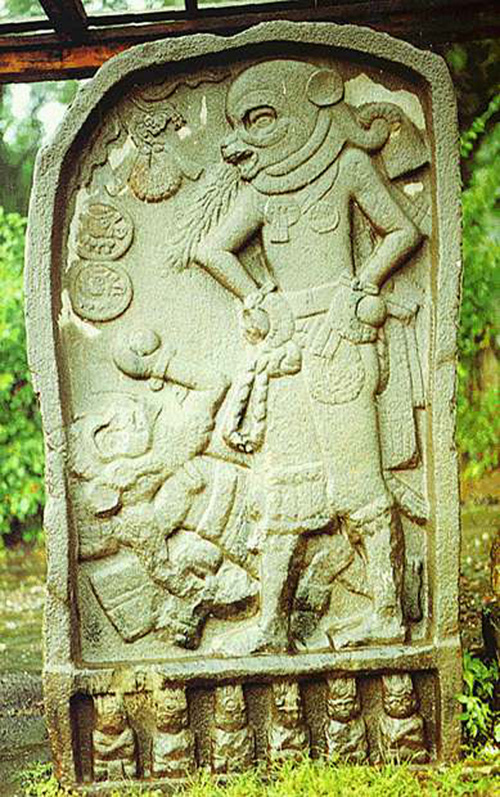
It becomes clear
that this carving is not showing a human body with a lions head. If you look
closely you can see an eye and the beginning of the nose. You can clearly see
that the human head wears a helmet. But helmets are nothing special. What is
special is that on the right side of the helmet emerges a tube that enters in a
small box.On the left side of the helmet you can clearly see a snout of an
animal and out of this snout there is smoke or fire shooting. This carving is
roughly 1500 years old. Would it be newer, nobody would have a problem to say
that the above is a misunderstood Hepa filter of some sort.
What those two examples show is that the simplest explanation does not always
have to be the right one.
|
4. Wasn't the Ancient Astronaut Theory and many of it's pillars already debunked?
Many “pillars” of the ancient astronaut theory have been
dismissed or “debunked” over the last two decades. And that by famous
scientists. Yet many ancient astronaut publications contain the same old things
over and over. Eg. Everybody now knows that the Easter Island statues were
built by humans, not aliens. Science found out exactly how they were built and
when they were built. But yet, they keep appearing in books about ancient
astronauts over and over.
Answer:
Well just because a Dr. or Prof. Has an explanation for something, doesn't
necessarily mean it is the right one. A good example for such an
“explanation” is the main temple of Olantaytambo in Peru. There,
perched high above the village of Olantay of today is a structure built with
gigantic monolitic stones. Each stone weighs thousands of tons and could only
be lifted with advanced technology today. Only the biggest cranes available to
heavy construction companies could move them.
Yet, the ancient inhabitants were able to move them with those technical help.
At least that is what archeologists suggest. The argument was made that all you
need to move heavy rocks is people. Lot's of them. It was calculated that the
combined strength of about 2000 men were able to move the gigantic stones up
the hill. So-and-so many people, moving so-and-so many tons. The math adds up
and that is all that matters. It seems like a no brainer, case closed and
another “pillar” of the Paleoseti theory gone. All that is left is
that a book has to be published that can be quoted by the critics. In many
forum discussions I was attacked by critics that dismiss the “ancient had
technical help from outside” theory, because of the calculations that were
published.
The problem is that most of the critics never visited Ollantaytambo. Because
once you have seen the site, you immediately understand that all of those
calculations don't work. And here is why.
Take a look at this photo I took during my Peru visit in 2005:
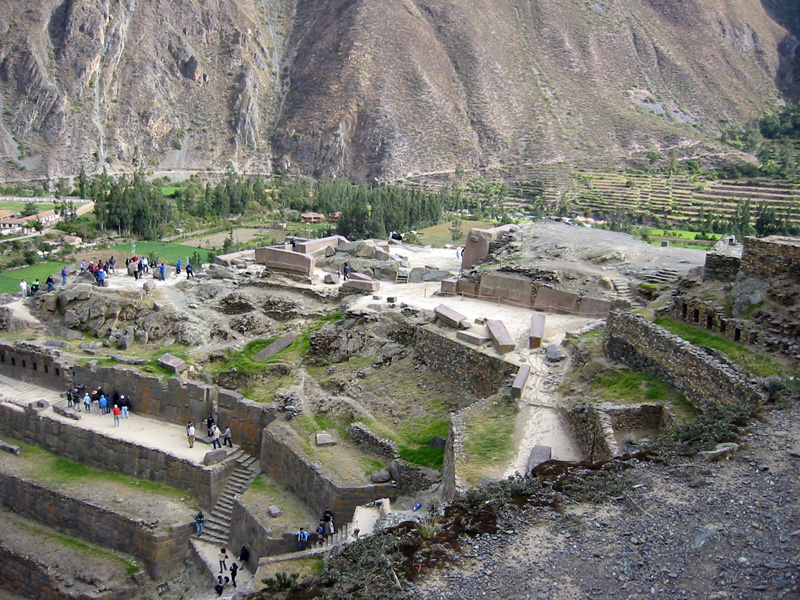
What makes this
photo interesting is the fact that it shows a good overview of the megalithic
temple of Olantaytambo. You can see the huge stones marked in red. Those are
the stones archeologists think hundreds and thousands of workers dragged up the
mountain to its current location. You can read more about this if you go to my
Olantaytambo page.
What's interesting for now is the group of tourists that stand on the left side
of the photo.
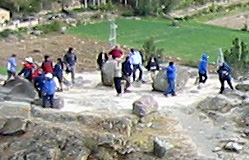
Just count the
number of people that stand there. If you counted 16, you are correct. Now we
do a little quick and dirty Photoshop magic. The next photo shows the group of
16 people cloned 6 times and spread all over the temple area. That's 16x6=96
people.
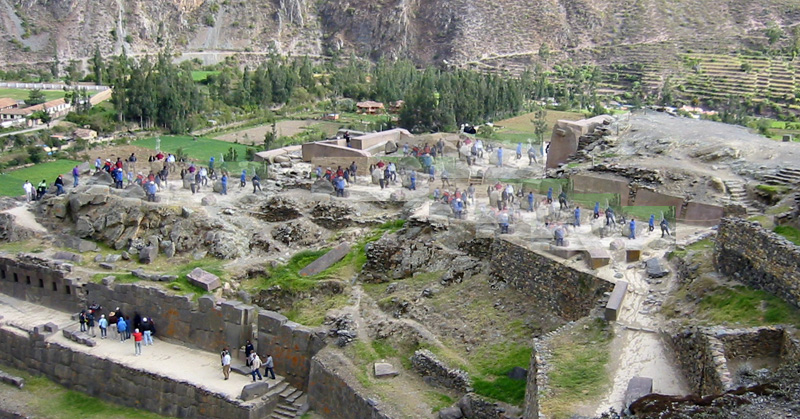
It starts to look
crowded, doesn't it? Now imagine multiplying those people by 5 and then
doubling them again. Then you have 1000 workers. Those numbers of workers are
needed to drag the blocks up the hill. It just does not work, there isn't
enough space on the platform for that many people. Let alone hard working ones.
And you don't have to be a Professor to figure this one out! You just have to
go there and look for yourself.
Why has nobody ever pointed that out? Well a somebody smart wrote it in a book.
So it has to be right...
Something I find really offensive, though, is that critics always
seem to use the word "debunked" if they talk about a difference of
opinion in regards to the Ancient Astronaut Theory. "Debunking" means
to me that you resolve something that was made up to decive. This is
not a way productive discussions take place.
Let me make one thing really clear. I think that the Ancient Astronaut
Theory is a VALID Theory that nobody will "debunk". The word "debunk"
is deeply disrespectful in a scientific context. Maria Reiche, the
great grand dame of Nazca research theorized after years of research
that she thinks the Nazca lines were some kind of a calendar. Today
many researchers don't think this is right. But nobody ever said Maria
Reiche's Theory was "debunked". Why is that?
|
5. We have not found a single shred of evidence of extraterrestrials in any
archeological dig. If the aliens were in fact here shouldn't we have found
something by now. Something clearly extraterrestrial in origin?
Answer:
I can see the point. We humans, especially we “civilized” ones have a
bad history of leaving things behind. Trash is littering our oceans and
forests, and every time we had an “encounter” with native people we
left something behind, just like every war leaves tank ruins etc.
But what would happen if further in the future our way of thinking will change?
What if our “environmental” consciousness progresses?
The “civilized” world is already aware that we can't pollute our
environment forever and if we want to conserve our nature and – ultimately
– our society, we have to change the way we live our lives.
That means that new more environmentally friendly products will be produced for
pretty much everything. Our modern cars are already made with end-of-life
recycling procedures in place. As I'm writing this I'm eating my soup with a
spoon that's made entirely of corn starch.
Although the spoon feels like plastic, it will be completely dissolved within
weeks of it going to the landfill. More and more products like this will be
introduced and eventually all our products will be like this. It's not a matter
of IF that happens, it's a matter of WHEN.
Now imagine a society that is hundreds if not thousands of years ahead of ours.
Especially a society that lived for many generations in spaceships where
everything HAS to be recycled.
It would be easy and natural for them to use only products that are completely
bio degradeable, and they must have had operating procedures in place that made
sure to leave as little trace as possible.
And I think this is exactly what happend in the past.
The ancient astronauts were using instruments and equipment that did not leave
any trace if lost or broken. I'm convinced the Ancient Astronauts were very
aware not to leave any technological traces behind that our ancestors could
misuse. (But every perfect plan has its flaws. A few items might have been
forgotten, but this is another subject, you can read about here.)
Another problem is that ANYTHING found that is out of the ordinary is
declared a fake! How can you proof something if the proof is "not
admissable"? The best example for this are the crystal skulls. The
Belize skull from Luubantun in Belize was declared a fake because they
found microscopic tool marks on it. The Lady that found the skull,
said, no she swore! that she found the skull in the ruins of the
ancient Maya city. Why would she lie? Her family never sold the skull
or gained any advantage from it. If there are modern tool marks on the
skull, but it WAS found in ancient ruins, isn't that the proof that
everybody wants? So ancient astronaut theorists can't win. On the one
hand a proof is wanted, on the other hand no proof is accepted.
|
6. There are no scientific works whatsoever in the Paleo-Seti field.
Every Paleo-Seti publication is written in popular style for a non scientific
audience. Therefore the Paleo-Seti Theory can't be taken seriously. Furthermore
pretty much all authors in the Paleo-Seti field are not archeologists, and very
rarely have a degree in any related field. How can you take them
seriously?
Answer:
How many scientific works to you know that were written by amateur
archaeologists? Or amateur scientists in general? How many amateurs do you know
that are taken seriously by any scientific field?
Unfortunately there is no university or college course on the Ancient Astronaut
Theory you can take anywhere in the world.
Scientific study of a subject takes a lot of research and funding. There are
very few “full timers” in the world of Paleo-Seti research. And all
of them are book authors. And only very few of those authors make enough money
to survive. They have no University or government grants behind them to back
them up if their next book does not sell well. And let's face it, not a lot of them do.
Therefore Ancient Astronaut researchers have to keep their publications attractive to a broad range of
readers. And unfortunately that's when scientific research DOES NOT come in
handy. Scientific publications do not sell well and have a very limited
readership. Steven Hawking knows exactly what I'm talking about. Not many
outside the scientific community knew his name until he published is popular
book “A short history of time”.
What was the secret of the book? Lay men's terms and NO FORMULAS! That
and an
interesting personal story is how you sell books. On top of everything
are the
publishing houses that want to make the most profit possible of course.
Editors
take whole passages out and streamline every publication. You want a
scientific work with Paleo-Seti background? Try Lutz Gentes' "The
reality of the Gods". Unfortunately only available in German as far as
I know. Did the book sell well? No, because it's written in scientific
style.
So it is not true that there are no scientific works about the Ancient Astronaut Theory, just nobody knows about them.
Also, a surprising number of scientists is very interested in the
Theory. I found that out in many private conversations with
Archaeologists, Geologists and others. But they all fear ridicule and
not being published anymore if they say anything positive about the
theory. This is not a conspiracy theory, it is a fact of how science
works nowadays.
You have to keep in mind that Archaeology and Anthropology are not
exact sciences like Physics, chemistry or Math. While in Math 2+2
always equals 4, in archaeology one find can change EVERYTHING and can
be interpreted in one way or another. In fa,t in todays Archaeological
world every
new major find is disputed, interpreted and then disputed again. In the
end you have 50% of archaeologists saying one thing and 50% of them
saying the exact opposite. If you want a prime example for this, you
google "sky disc of Nebra" (sometimes referred to as the star disc of
Nebra)
To come back to the original question: How can you take the Ancient
Astronaut Theory seriously if very little "serious scientific"
publications are around? Well I of the opinion that - scientific or not
- the Ancient Astronaut Theorists have done a very good job in pointing
out things that either do not work or need a fresh look in official
Archaeology.
And keep in mind if two scientists argue about the same thing and
have opposite opinions, one of them IS wrong. That's how science works,
and the Ancient Astronaut Theory is part of it.
|
7. The ancient people were not stupid. They had just as much brain power as
we have today. They didn't need extraterrestrial help to build the ancient
monuments. They did it themselves and the monuments are a document to their
ingenuity! It is insulting to the ancient people to say everything was built by aliens, because they couldn't do it themselves!
Response:
Absolutely correct! The ancients were not stupid. So why do archeologists make
them look like they were? If you open pretty much any archeological book you
will find out that the ancients were superstitious sex fanatics, liars (because
all their legends and myths are of course completely made up) and – on top
of everything – they were constantly high on drugs. They did have great
artists who knew how to draw animals, penises and everything else easily
identifiable, but they most definitely were on drugs when they painted beings
with helmets, antennas and other technical looking equipment. Shamanism is the
archeological description for ancient people on drugs.
Yes, the ancients were not stupid! They knew exactly what they drew, they knew
exactly what they wrote down and knew exactly what they remembered! That's what
the Ancient Astronaut Theory is saying.
But it gets very interesting if it seems that an ancient society has
discrepancies in the knowledge they acquired. Societies don't evolve in one but
in many directions. Our own society is the best example. We made huge advances
in medicine, astronomy, computers and every other field of research. The
ancient Greeks and Romans had fantastic knowledge in astronomy, architecture,
medicine, weapon technology and warfare among many other things. Because their
culture developed gradually in every direction.
But there are outliers during world history that just don't fit this picture.
The Inca built incredible structures that we would have a hard time matching
today. But otherwise they basically lived in the stone age.
The Mayas were able to calculate solar eclipses thousands of years in advance,
but – according to archaeology – they did not know one of the most
basic achievements of the human race: The wheel. If you visit rural Mexico
today, the houses and buildings are just like they have been thousands of years
ago: Twigs and bamboo. And yet, we see Tikal, Palenque, Chitzen Itza,
Teotiuacan and all the other fantastic buildings.
Isn't that odd?
|
8. Paleo-Seti theorists only see what they want to see. They take findings
out of context, compare apples to oranges and focus in on the
“unusual” when - under closer inspection – the find is not
unusual at all.
Answer:
You bet! We see what we want to see! That is the big difference between ancient
astronaut research and e.g. Egyptology. The Egyptologist ist only
“allowed” to look at Egypt. They are not allowed to compare the
Egyptian “apple” to the Mayan “orange” although they taste
and look the same. The Paleo-Seti Theorist can taste both forbidden fruits and
see if they have a common route.Research and progress means that sometimes we
have to take a look at old contexts and give them a new meaning. That's how
humans discover new and exciting things. That's how progress is made.
Yes, the ancients were not stupid! They knew exactly what they drew, they knew
exactly what they wrote down and knew exactly what they remembered! That's what
the Ancient Astronaut Theory is saying.
But it gets very interesting if it seems that an ancient society has
discrepancies in the knowledge they acquired. Societies don't evolve in one but
in many directions. Our own society is the best example. We made huge advances
in medicine, astronomy, computers and every other field of research. The
ancient Greeks and Romans had fantastic knowledge in astronomy, architecture,
medicine, weapon technology and warfare among many other things. Because their
culture developed gradually in every direction.
But there are outliers during world history that just don't fit this picture.
The Inca built incredible structures that we would have a hard time matching
today. But otherwise they basically lived in the stone age.
The Mayas were able to calculate solar eclipses thousands of years in advance,
but – according to archeology – they did not know one of the most
basic achievements of the human race: The wheel. If you visit rural Mexico
today, the houses and buildings are just like they have been thousands of years
ago: Twigs and bamboo. And yet, we see Tikal, Palenque, Chitzen Itza,
Teotiuacan and all the other fantastic buildings.
Isn't that odd?
|
9. Many authors of the Ancient Astronaut Theory are publishing books about
the same stuff over and over again. Same photographs, slightly different texts.
They also copy each other and is someone makes a mistake, it is copied and no
questions are asked. This discredits the Ancient Astronaut
Theory.
Answer:
Unfortunately this is correct! The Ancient Astronaut theory has to find back to
grassroots research. Researchers have to focus more on new findings then making a
quick buck. I personally know authors that have never visited any of the
ancient sites themselves, yet publish book after book about all kinds of
things. A good indication of such an author is usually the sparing use of
photographs. Due to license issues it is difficult and expensive most of the
time to use other people's photos in books.
I believe very strongly that if you publish material about the Ancient
Astronaut Theory, you can't do it with "armchair knowledge"
alone.
|
10. I have seen the TV show “Ancient Aliens”. Does that show
reflect the Ancient Aliens Theory correctly?
Answer:
My personal opinion about the TV series is divided.
There are quite a few good episodes, but there are also really bad ones. The
same can be said about the “presenters”.
The biggest problem about the show is that very little background information
is being given which would be necessary to understand the subject better. This
is of course a limitation of the 45 minutes that one episode is running. But
what would stop the producers to make a two episode special about key subjects
like Nazca or Tiahuanaco? Instead they could drop the idiotic Big Foot and
Ghost episodes that have absolutely nothing to do with the Ancient Astronaut
Theory.
But overall I'm happy that the TV show is on. It keeps the discussion about the
Theory alive and introduces it to new people. I think the producers should be
very careful, though and keep the show within scientific principles without
being “to stuffy”.
|
12. Ancient astronomical alignments and the ancient people's obsession with
the stars have nothing to do with extraterrestrials as you state on your
website and other authors of the ancient astronaut theory often claim! The
ancient people needed calendars to determine when to plant crops etc. Also, the
ancient people had a deeper connection with nature in the first place. They had
no TV or other distractions, so they had nothing else to do then to watch the
night sky in the evening. Therefore they were fascinated with the moving stars,
and all other forces of nature like lightning etc. Naturally, those forces of
nature turned into gods and believe systems in ancient legends. That's what we
can read in the old books today.
Answer:
The above statement needs a very complex answer. For starters the statement
contradicts itself.It is absolutely correct that the ancient people were more
routed in nature as we in the western societies are today. But the world is a
big place and we still have cultures that live their lives close to – what
we believe – the ancient societies lived theirs. So we do have a frame of
reference today. All we need to do is go in the e.g. Jungle were many
indigenous societies live like their ancestors thousands of years ago. The
first thing you will find completely absent is the worry about time and
calendars.
I grew up in a developed part in the western world: Rural Germany. Although m
parents have not been farmers, many of my friends parent's were farmers for
many generations. We once learnt the old German folk song in school “Im
Maerzen der Bauer die Roesslein einspannt...” which means translated
“In March the farmer puts his horses to work...”. I remember
very vivid when I and my friend George (whose dad was a farmer) were sitting
around their kitchen table to memorize the song for homework. George and I were
maybe 7 years old.
We asked George's dad when March will be in hope we will see the big traktor he
had and he answered: “Boys, this is just a folk tale. We have to start our
work not in March, but when it get's warmer outside. If there is still snow in
March, our horses will stay in the stable.”
How right he was! Farmers and all other people that live from the land don't
need a calendar to know when to do what.
|
13. You have very little quotes and credits on your website. This is not
scientific! Therefore you are not credible!
Answer:
If I quote out of a book, I will put quotes and/or credits in my texts. If I
quote from webpages, I will post a link (unfortunately the internet is a very
“fluent” medium. Websites and links change.)
The field of the ancient astronaut theory is extremely diverse. If I write
about Egypt, Peru or any other culture, I touch things that are their own study
fields in the universities around the world. Therefore I can't possibly know
every book.
Furthermore I do my own research and think with my own head. If I have an idea
by myself I strongly feel that I don't have the duty go through all the
literature to check if somebody had a similar idea before me. It's a bit like
in photography. Nobody owns the right to the pyramids in Egypt, so everybody
can take a photo of them. Also many of them show them, each photo is a bit
different.
The most ridiculous thing that happened to me was during my research of the
Dolmens in Nova Scotia. There is absolutely no literature available anywhere
and my own research in the subject was pretty much groundbreaking. All the
hints I got at the time were from local “hearsay” from wood workers
and other word of mouth sources. The only book that mentioned one of the
structures was a locally published and I mentioned and quoted it on my website.
After I published the story on several mailing list that dealt with archeology
and Paleo-Seti, I was attacked several times because I would not list my
“sources” scientifically with proper footnotes etc.
Now, how do you list sources if you have none? How do you quote somebody if
there is nobody to quote? If you do your own research and discover something
NEW, you will have a hard time with that.
Nobody can know every piece of literature, so it's entirely possible that
somebody, somewhere had the same idea I had. You will never ever find a quote
from any source on my website that I copied from somewhere. I never made money
with my site and with my thoughts and I probably never will. Why would I
“steal” something, put on the internet if I have absolutely no profit
from it? If you find anything on my website, that you feel belongs to you or
anybody else, be it a text or photograph, email me.
|
14. What do you think is the best proof for the Ancient Astronaut
Theory?
Answer:
I try to present the best stuff on my Website.
Unfortunately, I'm a spare time researcher that has a full time day job and
updating the site is sometimes difficult. It is my lifelong quest to visit all
the most interesting sites myself, so that I know first hand what I am writing
about. Here is a quick list of facts that I think are the best proof for the
theory:
a) The worldwide similarities in myths in the ancient people. Especially myths
about gods that descended from the sky and tought the ancients in all kinds of
subjects.
b) The worldwide similarities of building techniques in ancient times right
back to the stone age. Especially the fact that the older a site is, the more
incredible is the weight of moved stones.
c) The Nazca lines in Peru.
d) Puma Punku (Tiahuanaco) and Saqsayhuaman in Bolivia and Peru. The stoneworks
there are so incredible, they are very hard to explain with anything other then
extraterrestrial/advanced tools and techniques.
e) The Giza plateau in Egypt and other ancient Egyptian sites.
f) The worldwide astronomical alignments of the “megalithic culture”
and the ancient's “obsession” with the stars and sky. What makes this
especially interesting is the combination with a)
g) Cults and rituals that are very similar worldwide and have something to do
with body altering in order to look like the gods. You can read more about
those cults in the "PaleoSeti Mysteries" section of this website.
|
15. Let's go back to the “evidence” you present. I can see your
argument that all the artifacts potential aliens have left behind are gone by
now or under lock and key. But honestly I don't buy it. I still need
“hands on” proof that something was done with extraterrestrial
technology, tools. Something like the “ultimate not disputable proof”
that those aliens were here.
Answer:
Do you think the earth is round? Of course you do! But why do you think that?
It's because all the evidence points to it. Photos have been taken by
Astronauts, the earth's circumference has been calculated. Everything we know
tells us the Earth is round.
And yet only a handful of people have every seen this fact for themselves. All
we others have to trust the circumstantial evidence that the Earth is round.In
fact, I find the above question very fatalistic and dangerous to be honest.
Thank god criminal courts don't argue the same way as the question above
suggests or 99% of all criminals would walk free.
The question above suggests that you can only convict a murderer if you have
video evidence of the killing.
Everything else would not be admissible.
Circumstantial evidence is a valid form of proof and is in use in the justice
system for hundreds if not thousands of years.In archaeology circumstantial
evidence is pretty much the only way to proof a theory as we will never know
for certain how the ancients really lived. Nobody was there. So to demand
Ancient Astronaut theorist to come up with this mysterious
“undeniable” physical proof is highly unscientific and – quite
frankly – unfair. That's not how science works and if you think that way,
you have to dismiss a big part of all scientific research and better release
99% criminals out of their cells.
|
16. There is so much conflicting information on the internet. I don't know
how to inform myself about the Ancient Astronaut (PaleoSeti) Theory. Do you
have any tips?
Answer:
For everything nowadays we have a complete “information overload” for
pretty much everything and the PaleoSeti Theory is no exception. If you are new
to the theory and want to start getting into it, it's pretty hard to filter out
what is useful information and what not. My personal recommendation is to start
with some good old books.
There are several authors I can recommend but I think the best ones are
concentrated in the German language. Some of those books are a bit hard to come
by in a decent English translation.
A good starting point is certainly the books by Erich von Daeniken. He was not
the first one writing about the theory, but he certainly “jump
started” it into the mainstream. His first two books “Chariots of the
gods” and “Return to the stars” are a bit dated now, but still
give you a good foundation of what the theory is all about.
Erich von Daeniken had his best ideas and wrote the best books from 1975 until
about 1995. I find his books from the 80's a highpoint of PaleoSeti research.
After that he lost a bit of his “drive” and focused more on
repetition of what he already said in books before. With successful authors
like Erich von Daeniken it sometimes happens that publishing houses
“force” them to publish a new book, although they don't have anything
new to say.
Highly recommended are the books of Johannes and Peter Fiebag, German brothers
who write excellent stuff about the theory. Unfortunately English translations
are rare from those authors.In the anglo-american world of authors, I can
recommend the very well researched books of author Josef Blumrich who wrote
great books in the 1970s and 80s.
Choose your books wisely. Before I purchase a book from an author I don't know,
I usually do a bit of research of his/her other publications. Many newer
authors have a tendency of “cashing in” on old ideas. If the authors
other books include all kinds of new age stuff or many other unrelated fields,
I usually don't bother. PaleoSeti research requires dedication and a scientific
base, so if the author's other books are “Ghosts of ....” or
“The big foot mystery...” or “Healing crystals of the ancient
shamans...” I can pretty much guarantee you the books are no good.
Also, some authors are publishing books almost in quarter year intervals. I
strongly believe that good books with proper research take time to write.
The most important thing one can do is go to the ancient sites in question
yourself. Yes, it's time consuming and can cost money, but in the end it's
really worth it. You can read a hundred books about the pyramids, but no book
is a substitute for actually seeing them for yourself. No description does the
gigantic stones from Saqsayhuaman in Peru justice.
If money is a problem, you can visit interesting sites and museums just around
the corner were you live. Pieces of the global puzzle the Extraterrestrials
left for us are all over the globe, you just have to understand them.
It's also most important to read books about archaeological sites
that are not written by Ancient Astronaut Theorists to get the full
picture of what a site is all about. Only then you can judge what's out
there. Archaeology is NOT an exact science even if Archaeologists
wouldn't agree with this statement. If you read literature about an
ancient site from three different archaeologists you will get three
different opinions. So it's good to know what opinions are out there,
not just what Ancient Astronaut Theorists have to say.
Ten years ago internet forums used to be a great source of information and
knowledge exchange. Unfortunately that is no longer the case.
|
17.
Why are your pictures on your website so small? I tought you are a
photographer. Can't you provide us with higher resolution images so we
see more detail.
Answer:
I don't post higher res images because
I'm a photographer. The lower resolution of my images ensure that my
images are not appearing in publications without me being compensated
for them. I find the images from paleoseti.com all over the internet,
in blogs, other websites and everything else you can think of. Many of
them do not even have an image credit. In fact if you do a search on
Google Images with the keyword "Puma Punku", a good 30% of the results
are the images I posted here on paleoseti.com.
I'm very realistic
about stuff like that and understand that when I publish my photos on
the internet that will happen. And it's fine, in fact it's kind of
flattering.
What I don't like, though, is when I see my photos in commercial
publications without being compensated for it. One good example was a
multi million Dollar Hollywood movie production that advertised the
movie with one of my dolmen shots. They never asked for permission nor
did they pay me a cent for the image. I don't know about you, but I
find that unfair.
For not-for-profit research projects I usually grant
permission to use my images and I even send out higher res shots. But
for commercial projects I charge.
I think that the images on the website have enough resolution for
anybody to see what's important. If you think different and would like
to see more detail in a particular shot, email me.
|
18.
Something in the Ancient Astronaut Theory doesn't make sense. The
artifacts, buildings and "mysteries" you talk about and that you claim
are connected, are in fact not only far apart in distance but also in
TIME! The Egyptian Pyramids for example are thousands of years older
compared to their Mayan "counterparts". In one article you compare the
"Venus of Willendorf" figurine with an figurine found in Equador. The
"Venus of Willendorf" is 25000 (!) years older then the Equadorian
counterpart!. This is outragous and makes no sense! You are comparing
apples to oranges.
Answer:
This is always the big "killer argument" that PaleoSeti critics seem to
have. The time difference between artifacts. In reality this problem is
not as big as you think. You just have think rationally about how
history and memory works. Since this is a very fundamental question,
this answer will be a bit longer, as I want to get it right.
I can explain what mean by giving you an example:
Every 9th grade Math book you will open all over the world will have a
name in them: Pythagoras! This guy seems to be everywhere, not just in
9th grader's nightmares and the books they have to read, but also in
other scientific publications of all shapes and sizes. If you wouldn't
know what or who this Pythagoras is, you would think the guy is pretty
much everywhere. In Russia as well as the US, in Europe just as much as
in Japan.
But not only this! He is not only present in the year 2014, that guy
seemed to have been around in 1950 and 1897! Heck, he might have been
mentioned somewhere in 1000AD!
Now, if you do some more digging, you might
unearth (literally!) an ancient text in Greece mentioning that guy in
400BC.
That's 2500 years of "Pythagoras uninterrupted"! And I'm willing to bet
a thousand bucks that this guy will be around for another 10000 years
if humankind survives that long. So why is nobody asking the above
question when we compare a book from 1930 mentioning Pythagoras with a
book from 2014?
Because we know that Pythagoras was a Greek Philisopher that lived around 530BC. We know that
is was him that found the Theorem for triangles among many other
things. In fact if his name is mentioned in publications they don't
mean the man himself, they - most likely - mean his theorems. The name
Pythagoras stands for many things: A theorem, a historic person, but
most of all a memory. And memories are timeless.
Memories are carried over many thousands of years by different means.
Many cultures choose writing them down, some choose oral tradition.
Some make figurines, buildings and other artifacts to keep the memory
alive. But they all "talk" about the same thing, something important
that happend in the past. Time has no meaning for memories as long as
they are kept alive. The only thing that can happen to them over time
are slight variations of the same theme, the same intial event.
And
that's exactly what we see all over the world. The ancient people
remembered the most traumatic event in human history. The realization
that there are extraterrestrials - pardon - gods that seem to have
superpowers. This event - or events as I believe there where several
contacts during history - where transported through time in the
memories of the ancient people. That's why we see similarities
worldwide (the saw the same things) and that's why time doesn't matter.
|
19.
Sorry, but archaeology doesn't need the PaleoSeti Theory. It can
explain pretty much everything without ancient Aliens. And the few
mysteries left can soon be explained without the help of aliens or
other "out there" things.
Answer:
This is a very poor way of seeing things,
in many ways. If history has proven one thing, it is that at any time a
statement like the above was made, it had to be revised not long after.
A good example of this is that the way Isaac Newton explained the
physics of our world in the 1700s didn't need Albert Einstein. In fact
physicists until the early 1900s were pretty content with Newton's
explanations. Yes, there were little things here and there that they
couldn't explain, but they were sure that they will find a solution for
them soon. Yet, it where those "little" problems that eventually
sparked Einstein's radical ideas and gave science a completely new
outlook. But in the beginning Einstein was confronted with the same
sentence above.
In fact, i believe that the above statement is just
as bad as medieval thought processes. The church in the 1500s didn't
need science. They could explain EVERYTHING with god and a believe
system. And if there where questions beyond that, they told the people
not to ask those questions. Or else. Galileo Galilei would know what
I'm talking about.
The question is not if archaeology NEEDS the PaleoSeti Theory. The
question is, if there is validity to the theory or not.
And
with the above statement we are not closer to an answer to the theory,
but we are a lot closer to a medieval view of the world. Archaeology is
far away from explaining everything. Such a statement is both arrogant
and ignorant. Even significant archaeological sites are only excavated
by a small percentage and nobody knows what finds we can still expect.
Archaeologist
are only human as well. They all have different backgrounds and
agendas. Unfortunately for science, an archaeologist in the middle
East, for example, will come to different conclusions depending on what
cultural and religious background he/she has. I can guarantee you that.
|
A 13 year old once asked me: "Why is history and archaeology so boring?"
Answer:
Because some people make it that way.
|
The fine
print: The
Copyright of all texts and photos on this website lies with me,
Herbert Eisengruber. All my photos are protected by international copyright
laws and can't be used for any purpose without written permission. If you would
like to use one or more of my photos for your project, please get in touch with me.
|
|

